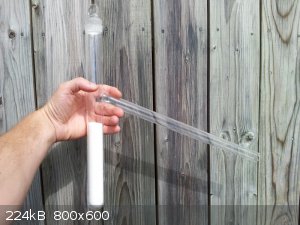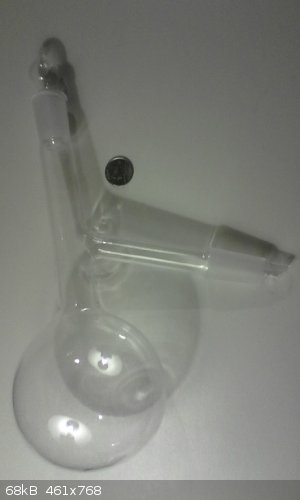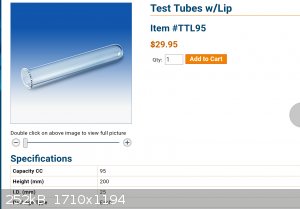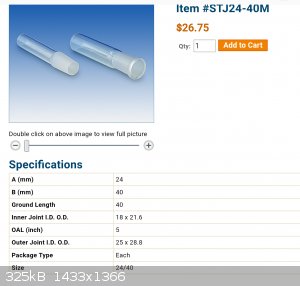Bert
Super Administrator
        
Posts: 2821
Registered: 12-3-2004
Member Is Offline
Mood: " I think we are all going to die. I think that love is an illusion. We are flawed, my darling".
|
|
Anyone working with Vycor or quartz glasses?
I have a high temperature project, and think I can source the parts. But I have never worked these high temp materials. Anyone equipped for and
experienced in working these materials? This needs to be done on a shoestring... I'd rather start looking here than asking around in China.
|
|
|
Morgan
International Hazard
    
Posts: 1660
Registered: 28-12-2010
Member Is Offline
Mood: No Mood
|
|
Are you going to use tubing or some other shape like a test tube or something else?
|
|
|
Bert
Super Administrator
        
Posts: 2821
Registered: 12-3-2004
Member Is Offline
Mood: " I think we are all going to die. I think that love is an illusion. We are flawed, my darling".
|
|
Basically, using a commercially available closed end tube, stock tubing and commercially sourced ground joints to counterfeit Hennig's oleum retort-
But with some modifications.
The output being a 24/40 male ground joint to allow a better exclusion of atmospheric moisture, the top closure a 55/50 female joint with a quartz
plug closure and the main body of the retort sized both longer and larger in Dia. (24" working length below arm, 2" OD, approximately) inside Dia. of
main tube relative to the top closure should allow the slug of Sodium sulfate waste to just be able to slide throuh and exit the top 55/50 neck after
cooling.
See here for Hennig's retort:
http://www.sciencemadness.org/talk/viewthread.php?tid=5495&a...

|
|
|
Magpie
lab constructor
    
Posts: 5939
Registered: 1-11-2003
Location: USA
Member Is Offline
Mood: Chemistry: the subtle science.
|
|
I have a 1" quartz tube, closed one end, about 18" long that I bought for making SO3. It has a ground glass opening which attaches to a tapered
borosilicate glass piece that conducts the SO3 into a receiver. The tube fits in my horizontal tube furnace. The tube end is male so material
expansion differences have no effect. I have this documented somewhere on this forum.
The single most important condition for a successful synthesis is good mixing - Nicodem
|
|
|
Bert
Super Administrator
        
Posts: 2821
Registered: 12-3-2004
Member Is Offline
Mood: " I think we are all going to die. I think that love is an illusion. We are flawed, my darling".
|
|
D'oh!
Reconsidering which sex joint for the openings. Thanks-
|
|
|
Magpie
lab constructor
    
Posts: 5939
Registered: 1-11-2003
Location: USA
Member Is Offline
Mood: Chemistry: the subtle science.
|
|
Actually Bert I mis-spoke here. Both pieces are quartz. Please see picture in this thread:
https://www.sciencemadness.org/whisper/viewthread.php?tid=10...
The single most important condition for a successful synthesis is good mixing - Nicodem
|
|
|
JJay
International Hazard
    
Posts: 3440
Registered: 15-10-2015
Member Is Offline
|
|
I have a quartz distillation flask with ground joints and two ground quartz tubes. I have been considering the construction of a fairly large tube
reactor, and I think Magpie's suggestion to use male joints on the sections that point away from the hot zone is a good one, if the joints will
interface with quartz, especially if hot substances will be flowing through them.
|
|
|
Chemetix
Hazard to Others
  
Posts: 375
Registered: 23-9-2016
Location: Oztrayleeyah
Member Is Offline
Mood: Wavering between lucidity and madness
|
|
I have designed and built quartz reactors for research, if you need specific details about something I could possibly be of assistance. But your
proposed use of a 55/50 quartz joint is expensive as hell and large joints are prone to freezing. Quartz is quite brittle, the force you can use to
unstick a borosilicate joint can often destroy a quartz piece.
Making a thick lip on the vertical tube and forming a V shaped plug to sit in this rim, can be then made to seal with a bit of hand grinding with some
silicon carbide grit. Some lugs and springs to hold them together should be enough to seal the apparatus given the low back pressures. It's crude but
bullet proof.
|
|
|
markx
National Hazard
   
Posts: 645
Registered: 7-8-2003
Location: Northern kingdom
Member Is Offline
Mood: Very Jolly
|
|
I've worked a lot with quartz rotary tube and fluidized bed chlorination reactors during my time in the research of "carbide derived carbon".....it is
a difficult material to manipulate. It can resist reasonable compressive loads (as load that is applied to a tube wall from the outside), but the
opposite will definitely lead to cracks in the quartz tube. It was quite a hazzle mounting a 2,5m long quartz tube into the reactor without breaking
it and then installing the magnetic rotary head, heat shields and graphite bushings....it was an interesting time 
But long story short....we searched for quite a time to find a replacement for the quartz reactor core material, but no reasonable alternative could
be found in the field of metallic materials. All of them would corrode very fast in the high temperature chlorine environment and even quartz glass
itself was attacked by the halogen and eaten away quite fast. Within about half a year the reactor core would wear so thin it collapsed under its own
weight.
But perhaps in the case of oleum a metallic material could be found as a replacement for the quartz retort? Something from the field of stainless
alloys e.g? It would be so much more easily workable compared to making equipment from quartz...
Exact science is a figment of imagination.......
|
|
|
Magpie
lab constructor
    
Posts: 5939
Registered: 1-11-2003
Location: USA
Member Is Offline
Mood: Chemistry: the subtle science.
|
|
I have made SO3 using a 1" quartz tube 18" long in my homemade tube furnace. It's a piece of cake using NaHSO4 (a pool chemical). Garage chemist has
instructions in Prepublication. The temperatures just aren't that high.
The single most important condition for a successful synthesis is good mixing - Nicodem
|
|
|
Bert
Super Administrator
        
Posts: 2821
Registered: 12-3-2004
Member Is Offline
Mood: " I think we are all going to die. I think that love is an illusion. We are flawed, my darling".
|
|
(Scratches furiously with dull pencil on back of envelope, answer: More than I would ever need...)
50 lb. sack of Sodium bisulfate on ebay, $100.00 delivered...
|
|
|
JJay
International Hazard
    
Posts: 3440
Registered: 15-10-2015
Member Is Offline
|
|
I use this flask for sulfuric acid. The cap, which is quartz, is made of a material with a very slightly higher coefficient of expansion than the rest
of the flask and can be removed only when the flask returns to room temperature.
I did not request a cap with a slightly higher coefficient of expansion and have not seen them offered anywhere, but it seems like a reasonable
feature for a male jointed cap.
I have not used it for oleum yet, but I am pretty sure it will work just fine for that.

Quote: Originally posted by Chemetix  | proposed use of a 55/50 quartz joint is expensive as hell and large joints are prone to freezing. Quartz is quite brittle, the force you can use to
unstick a borosilicate joint can often destroy a quartz piece.
|
That is very interesting. I was thinking about using a large quartz joint also. I have noticed that very large quartz pieces often interface using
planar surfaces held together with clamps.
|
|
|
Bert
Super Administrator
        
Posts: 2821
Registered: 12-3-2004
Member Is Offline
Mood: " I think we are all going to die. I think that love is an illusion. We are flawed, my darling".
|
|
Looking at materials, and trying to understand their physical properties? Also the terminology.
Glass and Glass Ceramics- physical properties from MakeItFrom.com
Anyone got hands on experience with Vycor or Chinese Vycor knock offs as far as robustness in handling vs. quartz glass?
Vycor was a Corning copyrighted name for a modified glass, 96% silicon dioxide, 3-4% Boron oxide after chemical leaching of a starting material
similar to borosilicate glass. After fusing the porous, acid leached substance, I find a number of sources calling this material FUSED QUARTZ. Which
was confusing me... A lot of the Chinese product is billed as "fused quartz (vycor)" in particular. Is the name out of copyright? Are the Chinese just
using a word that gets them more Google hits, regardless of manufacturing technique and chemical makeup... I've run into THAT before.
Young's modulus listed for Vycor as 6.62x1010 Pa. Poisson's ratio .19, but that probably varies with WHICH Vycor.
Quartz glass, either from natural quartz or synthetic is advertised as 98%+ Silicon dioxide. Good thermal expansion coefficient, good chemical
resistance, high melting- and a pain in the ass to work due to brittleness, as noted by some here.
There are at least 4 different types available, largely based on SiO2 source and processing.
Young's modulus for quartz glass (type not specified) listed as 71.7x1010, Poisson's ratio given as .17
Good old borosilicate glass (from Schott)- Young's modulus listed as 63GPa, Poisson's ratio .20
Going off of these, brittleness of Vycor would seem to be between boro and quartz, but closer to boro.
[Edited on 12-2-2018 by Bert]
|
|
|
MrHomeScientist
International Hazard
    
Posts: 1806
Registered: 24-10-2010
Location: Flerovium
Member Is Offline
Mood: No Mood
|
|
It sounds like you might already have your apparatus, but in case you need more quartz I wanted to recommend Technical Glass Products www.technicalglass.com/
Most suppliers I found had minimum order quantities of way more than I'd ever need, but TGP was willing to work with me and let me buy just one stick
of tubing. Very accommodating and friendly. They also sell all sorts of quartzware besides tubing, and do custom jobs. Bert, shoot me a U2U if
interested and I'll send you the contact info for the guy I talked to there.
|
|
|
JJay
International Hazard
    
Posts: 3440
Registered: 15-10-2015
Member Is Offline
|
|
Donghai Yukang Quartz Material is about half as expensive as TGP and has a much shorter turnaround time on custom jobs. They are also flexible and
have considerable expertise.
|
|
|
Bert
Super Administrator
        
Posts: 2821
Registered: 12-3-2004
Member Is Offline
Mood: " I think we are all going to die. I think that love is an illusion. We are flawed, my darling".
|
|
No, I have not ordered anything yet. I am too busy overthinking this, as is my wont.
Here's a thought experiment-
So, fuse one of these:
http://www.technicalglass.com/95cc-fused-quartz-test-tubes-w...

Onto the male version of one of THESE:
http://www.technicalglass.com/stj24-40m.html

And you end up with pretty much the basic Large-test tubeube-with-a-male-joint described by Magpie, interior dimensions about 13" x 1", capacity of
perhaps 135ml exclusive of ground joint.. For under $60.00 US in parts.
Let's say you fit about 100ml powdered Sodium bisulfite in there, at an apparent bulk density of 1.442 g/cc. for a charge weight of about 144 grams,
let's be lazy and round THAT down to 1mol (1mol anhydrous NaHSO4 = 142.04g)
http://www.sciencemadness.org/talk/viewthread.php?tid=10332
[Edited on 12-2-2018 by Bert]
|
|
|
JJay
International Hazard
    
Posts: 3440
Registered: 15-10-2015
Member Is Offline
|
|
You might want to check out TGP's boro to quartz transition tubes.
|
|
|
zed
International Hazard
    
Posts: 2277
Registered: 6-9-2008
Location: Great State of Jefferson, City of Portland
Member Is Offline
Mood: Semi-repentant Sith Lord
|
|
Umm. My experience with Crystalline Quartz, is that it is very strong, tough, and durable. A ringstone cut from it, may show no signs of wear or
chipping, after decades of wearing. Though crystals vary, somewhat in hardness, depending on origin.
I don't know what qualities crystalline quartz might exhibit if ground into labglass. But, I'm gonna go browse for it.
OK. I went, I looked, I gave up.
[Edited on 13-2-2018 by zed]
|
|
|